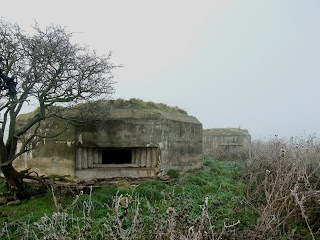Freezing fog last Monday did not put me off on getting out, so decided to check out the remains of a Diver Battery in the Walberswick area (the best remains of a Diver Battery I have found so far but that’s for a later post as still have not finished mapping all the remains yet). Anyway, decided to try to get some pics of two pillboxes at Blythburgh designed to house two Vickers MG’s each. They did look quite attractive in the freezing fog but as usual the camera failed to capture the ambiance!
I could imagine a German raiding party encountering these two – with four Vickers they could through out 1,000 rounds per minute at rapid fire. At rapid fire, each gun would get through 16 belts of ammunition every 15 minutes (30 minutes normal rate). Would have been a headache to keep these guns supplied in ammunition if invasion had been for real in this area.
The photos shows how the guns in these pillboxes would have dominated the ground. One can only imagine the discomfort of the gun crews with the noise and fumes let alone those on the receiving end!
The design of the pillboxes seems to be unique to Suffolk. They are shell proof with an L shaped blast wall. As well as these two I only know of the one at Benacre and one at Dunwich still surviving.
Image 1: Location of pillboxes with approx arc of fire
Image 2: Pillboxes in freezing fog
Image 3: Pillboxes on a somewhat better day!
Image 4 and 5: Area that the pillbox MG's covered
Images 6-8: More views of the pillboxes
Image 9: Concrete table on which the Vickers MG would have sat on









Comments
Post a Comment